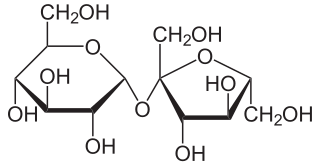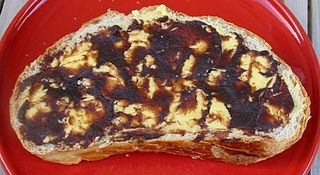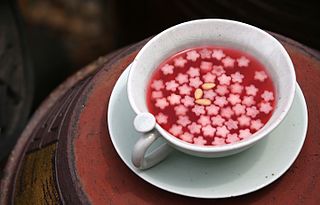
Vinegar is an aqueous solution of acetic acid and trace compounds that may include flavorings. Vinegar typically contains from 5% to 18% acetic acid by volume. Usually, the acetic acid is produced by a double fermentation, converting simple sugars to ethanol using yeast and ethanol to acetic acid using acetic acid bacteria. Many types of vinegar are made, depending on source materials. The product is now mainly used in the culinary arts as a flavorful, acidic cooking ingredient or in pickling. Various types are used as condiments or garnishes, including balsamic vinegar and malt vinegar.

Sucrose, a disaccharide, is a sugar composed of glucose and fructose subunits. It is produced naturally in plants and is the main constituent of white sugar. It has the molecular formula C
12H
22O
11.

Molasses is a viscous byproduct, principally obtained from the refining of sugarcane or sugar beet juice into sugar. Molasses varies in the amount of sugar, the method of extraction and age of the plant. Sugarcane molasses is usually used to sweeten and flavour foods. Molasses is a major constituent of fine commercial brown sugar.

Muesli is a cold Swiss breakfast dish, the primary ingredient of which is rolled oats. Traditionally, it is set to soak in water overnight and eaten the next morning with fresh fruit, nuts, lemon juice, and cream sweetened with honey. Additional ingredients, such as other grains, seeds, and dried fruits are sometimes added, and other citrus juice may be used. Yogurt, milk or other milk products, or milk substitutes are now commonly added to both homemade and commercially packaged muesli recipes.

Lemonade is a sweetened lemon-flavored drink.

Minute Maid is an American brand of beverages, usually associated with lemonade or orange juice, but which now extends to soft drinks of different kinds, including Hi-C. Minute Maid is sold under the Cappy brand in Central Europe and under the brand "Моя Семья" in Russia and the Commonwealth of Independent States. Minute Maid was the first company to market frozen orange juice concentrate, allowing it to be distributed throughout the United States and served year-round. The Minute Maid Company is owned by The Coca-Cola Company, the world's largest marketer of fruit juices and drinks. The firm opened its headquarters in Sugar Land Town Square in Sugar Land, Texas, United States, on February 16, 2009; previously it was headquartered in the 2000 St. James Place building in Houston.

Starburst is the brand name of a box-shaped, fruit-flavoured soft taffy candy manufactured by The Wrigley Company, which is a subsidiary of Mars, Incorporated. Starburst has many different varieties, such as Tropical, Sour, FaveREDs, Watermelon, Very Berry, Superfruit, Summer Blast and Original.

Golden syrup or light treacle is a thick, amber-coloured form of inverted sugar syrup made by the process of refining sugar cane or sugar beet juice into sugar. It is used in a variety of baking recipes and desserts. It has an appearance and consistency similar to honey, and is often used as a substitute where honey is unavailable.

Apple butter is a highly concentrated form of apple sauce produced by long, slow cooking of apples with apple juice or water to a point where the sugar in the apples caramelizes, turning the apple butter a deep brown. The concentration of sugar gives apple butter a much longer shelf life as a preserve than apple sauce.

High-fructose corn syrup (HFCS), also known as glucose–fructose, isoglucose and glucose–fructose syrup, is a sweetener made from corn starch. As in the production of conventional corn syrup, the starch is broken down into glucose by enzymes. To make HFCS, the corn syrup is further processed by D-xylose isomerase to convert some of its glucose into fructose. HFCS was first marketed in the early 1970s by the Clinton Corn Processing Company, together with the Japanese Agency of Industrial Science and Technology, where the enzyme was discovered in 1965.

Monster Beverage Corporation is an American beverage company that manufactures energy drinks including Monster Energy, Relentless, Reign and Burn. The company was originally founded as Hansen's in 1935 in Southern California, originally selling juice products. The company renamed itself as Monster Beverage in 2012.

Sugarcane juice is the liquid extracted from pressed sugarcane. It is consumed as a beverage in many places, especially where sugarcane is commercially grown, such as Southeast Asia, the Indian subcontinent, North Africa, mainly Egypt, and also in South America. Sugarcane juice is obtained by crushing peeled sugarcane in a mill and is one of the main precursors of rum.

Hwachae is a general term for traditional Korean punches, made with various fruits or edible flower petals. The fruits and flowers are soaked in honeyed water or honeyed magnolia berry juice. In modern South Korea, carbonated drinks and fruit juices are also commonly added to hwachae. Hwachae is often garnished with pine nuts before it is served.

Egg substitutes are food products which can be used to replace eggs in cooking and baking. Common reasons a cook may choose to use an egg substitute instead of egg(s) include having an egg allergy, adhering to a vegan diet or a vegetarian diet of a type that omits eggs, having concerns about the level of animal welfare or environmental burden associated with egg farming, or worries about potential Salmonella contamination when using raw eggs. There is a growing movement to address some of these concerns via third-party certifications, but because many labels in the industry remain confusing or intentionally misleading, some consumers distrust them and may use egg substitutes instead.

Sharbat is a drink prepared from fruit or flower petals. It is a sweet cordial, and usually served chilled. It can be served in concentrated form and eaten with a spoon or diluted with water to create the drink.

A bees knees is a Prohibition era cocktail made with gin, fresh lemon juice, and honey. It is served shaken and chilled, often with a lemon twist.
















